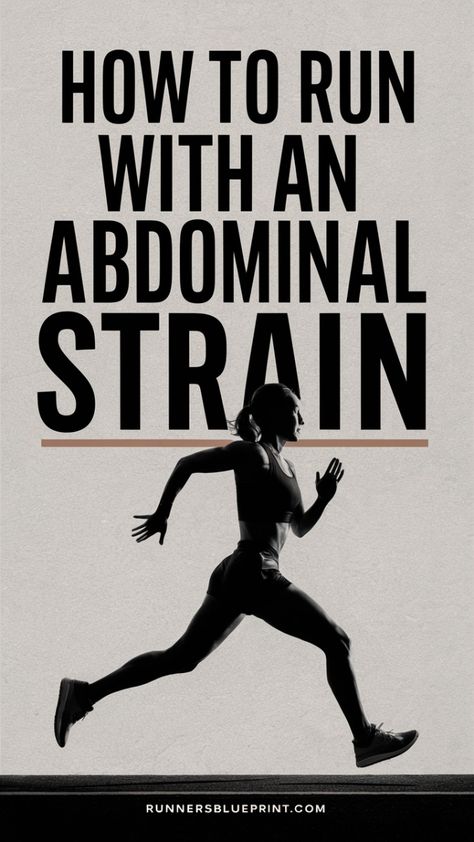Injuries sneaking up on you? We’ve all been there, especially with those unexpected ones like abdominal pain.
If you’ve ever experienced that sharp, uncomfortable pain in your core while running or even while doing something as simple as sneezing, you know it’s no joke.
But don’t worry! I’m here to walk you through everything you need to know about dealing with an abdominal strain so you can get back to running stronger than ever.
Let’s dive into what an abdominal strain is, how to spot it, and the best ways to treat and avoid it. Let’s jump in
What Is An Abdominal Strain?
An abdominal strain occurs when the muscles in your abdomen—those hardworking muscles that keep your core tight and stable—are overstretched or torn. These muscles can get strained from overuse, poor form, or even an unlucky twist in your daily routine.
The strain can range from a minor stretch to a full rupture of the muscle, which can seriously impact your ability to run and move comfortably.
When this happens, the pain is often sharp and immediate. You’ll feel it when you cough, sneeze, laugh, or take deep breaths. Even simple movements involving your trunk can trigger pain, making everyday life and running a challenge.
Strains can happen during intense workouts, lifting heavy objects without proper technique, or even during a fit of laughter.
Symptoms of an Abdominal Strain
If you’re wondering whether your discomfort is from an abdominal strain, here are some key symptoms to watch for:
- Sharp pain in the abdomen when you move, cough, or sneeze.
- Swelling or tenderness in the area around your abs.
- Bruising around the affected muscle.
- Stiffness that makes movement painful, especially after sitting or lying down for a long period.
If these symptoms ring a bell, it’s probably an abdominal strain—but with the right care, you’ll be back running before you know it.
Understanding the Causes of Abdominal Strains in Runners
Here’s what the research has to say about these common causes and why they might be affecting you.
Repetitive Strain and Overuse
Running involves continuous motion that can put repetitive stress on your core muscles, especially if you’re logging high mileage or doing intense interval training. Over time, this strain can overstretch or tear the abdominal muscles, leading to pain and discomfort.
According to research, repetitive strain from high-impact activities like running is one of the leading causes of muscle injuries, including abdominal strains. Runners, especially those who train frequently without adequate recovery, are at higher risk.
Weak Core Muscles
Your core plays a major role in stabilizing your entire body during a run, helping maintain balance and absorb impact with each stride. If your core muscles aren’t strong enough, the extra stress often gets transferred to the abdominal muscles, making them more susceptible to strains.
A study in the Journal of Strength and Conditioning Research found that athletes with weak core muscles are more likely to experience abdominal and lower back strains. Incorporating core-strengthening exercises into your routine can significantly reduce this risk. (source)
Improper Running Technique
Form is everything in running. If you tend to overstride, twist your torso, or lean too far forward, your abdominal muscles may compensate to stabilize your upper body. This extra load on the abs can lead to muscle strain, especially over long distances.
Research resported that biomechanical issues, like improper running form, are a common factor in core muscle injuries. Proper alignment and balance are essential for reducing unnecessary strain on the abdominals.
Can You Run with an Abdominal Strain?
Running with an abdominal strain? It depends on how severe it is.
If your pain is mild and manageable, running might actually help by promoting blood flow to the area, which aids in healing. Just keep the effort easy and listen to your body.
However, if the pain is intense or getting worse, it’s time to hit pause on running. Severe strains can worsen if you keep pushing, and you could end up sidelined for much longer. If you notice excessive bruising or the pain becomes unbearable, it’s best to consult a doctor to rule out a more serious issue.
Grades of Severity
Knowing how severe the strain is helps guide your recovery approach. There are three grades of muscle strains:
- First-Degree Strain: This is the mildest form of a strain, where only a small number of muscle fibers are overstretched. You’ll feel some discomfort, but there’s no loss of strength. Rest and some light stretching should help you recover quickly.
- Second-Degree Strain: Here, a greater number of muscle fibers are torn, leading to moderate to severe pain. You might experience swelling and muscle weakness. Running might not be a good idea until you’ve given your body more time to heal.
- Third-Degree Strain: This is the most serious type, where the muscle is completely torn. If you’re dealing with this, you’ll have intense pain, swelling, bruising, and a total loss of strength in the affected area. This injury requires immediate medical attention and possibly even surgery.
Abdominal Muscle Strain Vs Abdominal Hernia
It’s important to understand the difference between an abdominal strain and an abdominal hernia, as the two are often confused. A hernia happens when an organ or tissue pushes through a weak spot in the muscle wall. This can cause a visible bulge and worsens with movement or strain, often requiring surgery.
An abdominal strain, on the other hand, is just muscle damage—no bulge, but definitely some pain
If you’re unsure whether you have a strain or hernia, consult a doctor.
How to Treat an Abdominal Strain
So, you’ve got an abdominal strain—now what? Here’s how to treat it and get back on the road to recovery:
- Rest. Your body needs time to heal, and that means giving your abs a break. While your abdominal muscles are involved in nearly everything you do, try to limit movements that aggravate the injury. Rest is your friend!
- Apply Ice. Ice therapy can help reduce swelling and pain. Apply ice for 15-20 minutes every few hours, especially in the first 48 hours after the injury.
- Compression. Wearing a compression wrap or abdominal brace can provide support and reduce swelling. Make sure it’s snug but not too tight—you want to encourage healing, not restrict circulation.
- Pain Relief. Over-the-counter pain medications like ibuprofen can help with inflammation and pain, but make sure to follow the recommended dosage and avoid long-term use without consulting a doctor.
- Massage. Gently massaging the area (if it’s not too painful) can help improve blood flow and aid in recovery. Just be cautious and avoid pushing too hard.
How To Prevent Abdominal Strains
Once you’re back on your feet, you’ll want to avoid this happening again.
Here are some tips to prevent abdominal strains:
Always Warm up
As far as I can tell, the most common reason behind muscle strains during exercise boils down to a failure to warm up properly.
You can’t just jump into training without warming up—especially if you plan to do speedwork or something intense.
Instead, spend at least 10-15 minutes warming up.
I’d recommend you jogging slowly for five minutes to elevate your heart and breathing rates. Then perform a series of dynamic exercises, such as inchworms, leg swings, deep squats, lunges, and the sort—all of which will get your muscles ready for intense exercise.
Get Strong
A strong muscle is likely to tear or become compromised.
Check the following routines:
Build Proper Technique
Whether you’re doing sprints on the track or heavy squats in the gym, proper technique cannot be ignored.
Proper posture also matters when you’re not exercising. More importantly, avoid prolonged sitting in one position—this places additional pressure on your abdominal muscles.
What’s more?
When you try to lift a heavy object, engage your core, bend at the knees, then use your lower body muscles to lift, keeping the weight close to your body.
Stay Within Your Fitness Level
Want to prevent trouble in the future? Avoid overworking your muscles.
If you’re taking up exercise for the first time, whether it’s running, weight lifting, whatever, start slowly and build it gradually to more intense training.
Don’t try to bite off more than one can chew —or else you hurt yourself, and that’s just bad.
Consult your Doctor
Consult your doctor in case of pain hasn’t faded in spite of taking some of the above measures.
They may suggest an ultrasound to see if it’s a simple tear or something more, like a hernia.
Next, your doctor’s advice about running with abdominal strain will depend on the nature, location, severity of the tear, and your fitness and health levels.
Final Thoughts
An abdominal strain is no joke, but it doesn’t have to keep you off track
With proper care, rest, and a focus on prevention, you’ll be back out there in no time. Just remember to listen to your body, take things slow, and don’t push through the pain. Recovery is part of the process, and with the right steps, you’ll come back stronger and smarter.
Got any questions or want to share your experience? I’m here to help you work through it!


